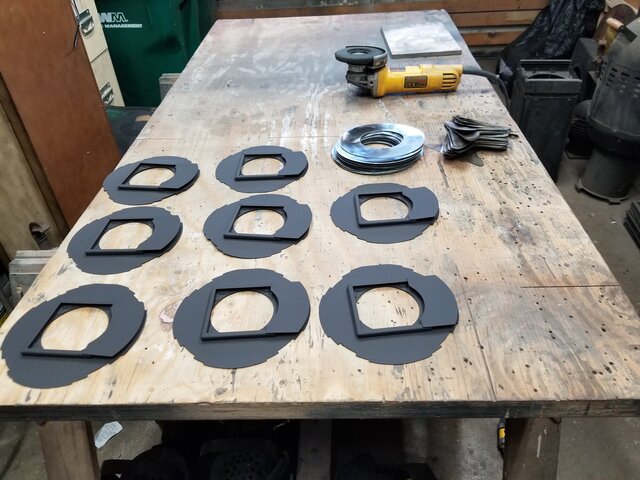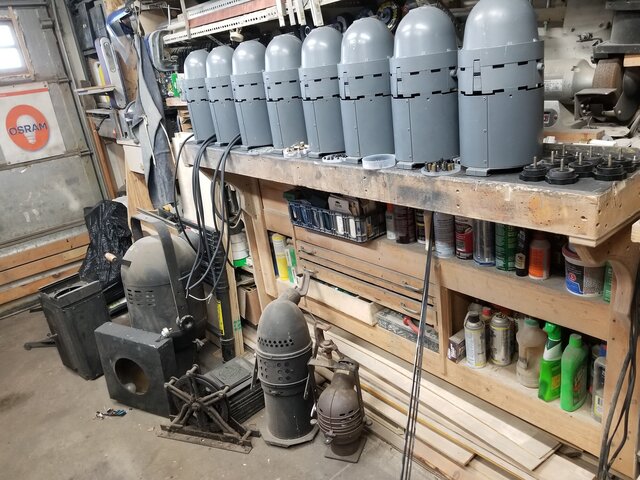You are using an out of date browser. It may not display this or other websites correctly.
You should upgrade or use an alternative browser.
You should upgrade or use an alternative browser.
Conventional Fixtures Altman 6" Fresnel Socket Problems
- Thread starterbwhiteford
- Start date
Neutral wire to front as per best practice.... If you could have a P-28s where either the neutral wire or the hot wire would be towards the front of the fixture accessible during lamp change... Just for the chance that a live hot conductor is compromized, and someone is changing a lamp on a live circuit it matters. Neutral wire to the front if not, should be a rule if not defined norm, in splitting hairs about the same focus but defined how to wire rational in standard.
@ship "changing a lamp on a live circuit"Neutral wire to front as per best practice.... If you could have a P-28s where either the neutral wire or the hot wire would be towards the front of the fixture accessible during lamp change... Just for the chance that a live hot conductor is compromised, and someone is it matters. Neutral wire to the front if not, should be a rule in splitting hairs but defined rational.
Changing a lamp LIVE? Wow!! Talk about your real men! Do you wear sunglasses and gloves or stare straight at it with your alcohol wiped fingers??
Toodleoo!
Ron Hebbard
Intent of most code, norms and what we do is to idiot proof end user usage.
We don't use 1900 boxes as per Edison plug with cord to duplex 2-gang outlet boxes unless at least the knockouts are welded. Not code and not safe. One of the knockouts could get pushed in and short, become de-attached and float about until shorting, and a larger than 1/4" opening - against code would be opened for finger to terminal shorts.
Darwin from high school thru IA.. as per a lamp inspector for "bad lamps"; I can tell lots about "trained staff" not following fixture manufacturer or lamp specification policy for lamp removal. Hot still very explosive lamps removed and burned into the road case or replacement lamp packaging. Lack of inspection as to why the lamp failed as to inspection of the failed lamp in now putting a perfectly good lamp into a bad lamp socket.
Bad lamps into bad sockets will on average last 100 hours less each time until the lamp socket fails finally. Swapping bad lamps between sockets spreads that virius. etc.
Constant findings that armature and professional Lighting Technicians just don't do their job properly or are not trained properly speaks to the Darwin electrical code theory of safety.
Do people change lamps while the circuit is live? Yes, and you and I have done this in our past. Do we recommend against if, of course!
Is it fair as a concept for a standard to put the wiring to a lamp socket where you have a choice in wiring for either the neutral or hot conductor wiring the lamp socket to be exposed potentially to touch.... Not in my opinion a huge problem for choice in orientating the wiring that way.
We don't use 1900 boxes as per Edison plug with cord to duplex 2-gang outlet boxes unless at least the knockouts are welded. Not code and not safe. One of the knockouts could get pushed in and short, become de-attached and float about until shorting, and a larger than 1/4" opening - against code would be opened for finger to terminal shorts.
Darwin from high school thru IA.. as per a lamp inspector for "bad lamps"; I can tell lots about "trained staff" not following fixture manufacturer or lamp specification policy for lamp removal. Hot still very explosive lamps removed and burned into the road case or replacement lamp packaging. Lack of inspection as to why the lamp failed as to inspection of the failed lamp in now putting a perfectly good lamp into a bad lamp socket.
Bad lamps into bad sockets will on average last 100 hours less each time until the lamp socket fails finally. Swapping bad lamps between sockets spreads that virius. etc.
Constant findings that armature and professional Lighting Technicians just don't do their job properly or are not trained properly speaks to the Darwin electrical code theory of safety.
Do people change lamps while the circuit is live? Yes, and you and I have done this in our past. Do we recommend against if, of course!
Is it fair as a concept for a standard to put the wiring to a lamp socket where you have a choice in wiring for either the neutral or hot conductor wiring the lamp socket to be exposed potentially to touch.... Not in my opinion a huge problem for choice in orientating the wiring that way.
@xander Quoting you: "It is a very simple and fairly cheap process to change the lamp base."re: Altman 6" Fresnel Lamp Base Problems
Yes, the lamp socket will wear out. And from the sound of it, yours have. Inside the socket there is a spring (which is what you press down when inserting the lamp) and it sounds like it is worn out, so it isn't able to press the lamp upward and make the connection. It is a very simple and fairly cheap process to change the lamp base.
-Tim
The lamp base, part of the lamp, OR the socket within the Fresnel?
Toodleoo!
Ron Hebbard
Often the lamp socket center plate (hot) can be re-surfaced, and the tension spring on it is just fine.
Of the spring, it is definitely a factor to consider but I normally would see a loose (neutral) locking mechanism atop the lamp socket which isn't something that can be fixed more commonly. This will also factor into spring tension or even being able to seat and lock the lamp properly.
At a time I was restoring a bunch of G-22 based 1950's (modern) Leko's, I would see this locking mechanism failure even more commonly. No idea of why G-22 base for Leko's became popular but they sucked in even more common for the latch mechanism failing.
Easy to change the lamp socket.... depends on often you have to re-drill mounting holes for the new lamp socket which is easy enough especially if you use the (provided) insulator to mount new holes with correct orientation of the fliament plane.
Always replace all 4-40 mounting screws & lock washers for the lamp socket - at least re-tap them. It will ruin your day when one of these siezes up and snaps new lamp socket or used. (Yes you can put that screw into a drill and re-tap it into a die handle.) Had a screw break on #7 of 8 Leko P-28s lamp sockets snap recently. Tried to drill out and re-tap without luck. Made for a perfectly good lamp socket to break apart for parts.
I actively work on old and reletively modern lighting gear for restoration in non-profit restoration (just need gear for free customers to give to). Today's work. Shutter spacers and gobo rings - a few hours of work not done yet. Fully restored and will last many years once done.
Next to them, antiques on the work list in free time. Finish the gate assembly, change all lamp sockets from P-28s to G-9.5 as per the Century #2321 I have and than won't have lamp socket issues in being P-28s due to design flaw in clamping it on that specific fixture. From the second 1925 Pevear from the theater, to late 1960's 4.5x6.5 Hub Leko I have seen in catalogues but never had.... Including even a c.1925 Magic Moon and the largest cannon of a Leko I have worked on yet, a c. 1950's Leko'. (Carrot on a stick for finishing the Leko's.)
Of the spring, it is definitely a factor to consider but I normally would see a loose (neutral) locking mechanism atop the lamp socket which isn't something that can be fixed more commonly. This will also factor into spring tension or even being able to seat and lock the lamp properly.
At a time I was restoring a bunch of G-22 based 1950's (modern) Leko's, I would see this locking mechanism failure even more commonly. No idea of why G-22 base for Leko's became popular but they sucked in even more common for the latch mechanism failing.
Easy to change the lamp socket.... depends on often you have to re-drill mounting holes for the new lamp socket which is easy enough especially if you use the (provided) insulator to mount new holes with correct orientation of the fliament plane.
Always replace all 4-40 mounting screws & lock washers for the lamp socket - at least re-tap them. It will ruin your day when one of these siezes up and snaps new lamp socket or used. (Yes you can put that screw into a drill and re-tap it into a die handle.) Had a screw break on #7 of 8 Leko P-28s lamp sockets snap recently. Tried to drill out and re-tap without luck. Made for a perfectly good lamp socket to break apart for parts.
I actively work on old and reletively modern lighting gear for restoration in non-profit restoration (just need gear for free customers to give to). Today's work. Shutter spacers and gobo rings - a few hours of work not done yet. Fully restored and will last many years once done.
Next to them, antiques on the work list in free time. Finish the gate assembly, change all lamp sockets from P-28s to G-9.5 as per the Century #2321 I have and than won't have lamp socket issues in being P-28s due to design flaw in clamping it on that specific fixture. From the second 1925 Pevear from the theater, to late 1960's 4.5x6.5 Hub Leko I have seen in catalogues but never had.... Including even a c.1925 Magic Moon and the largest cannon of a Leko I have worked on yet, a c. 1950's Leko'. (Carrot on a stick for finishing the Leko's.)
Attachments
Mac Hosehead
Well-Known Member
This reminded me of a story my TD used tell in my college days. He was on a ladder and was changing a lamp in a leko. The dimmer was down but the burn base was still plugged in. Some T20s in those days had a metal collar that extended up from the lamp base. He grabbed the lamp to push in and twist. His hand came in contact with the collar and he found he could not let go. He had to yell for someone to kill the circuit. The story was enough for me to remember to unplug a fixture before any servicing.But anyone who tries to insert a 500w T20 lamp into a hot socket doesn't belong in this biz.
Similar threads
- Replies
- 22
- Views
- 5K
Vintage Lighting
Radial Leko Lamp Socket Adaptors for Prop Lights
- Replies
- 3
- Views
- 2K
Vintage Lighting
A concern about early 1970's Century Leko's
- Replies
- 10
- Views
- 3K
Users who are viewing this thread
Total: 1 (members: 0, guests: 1)




